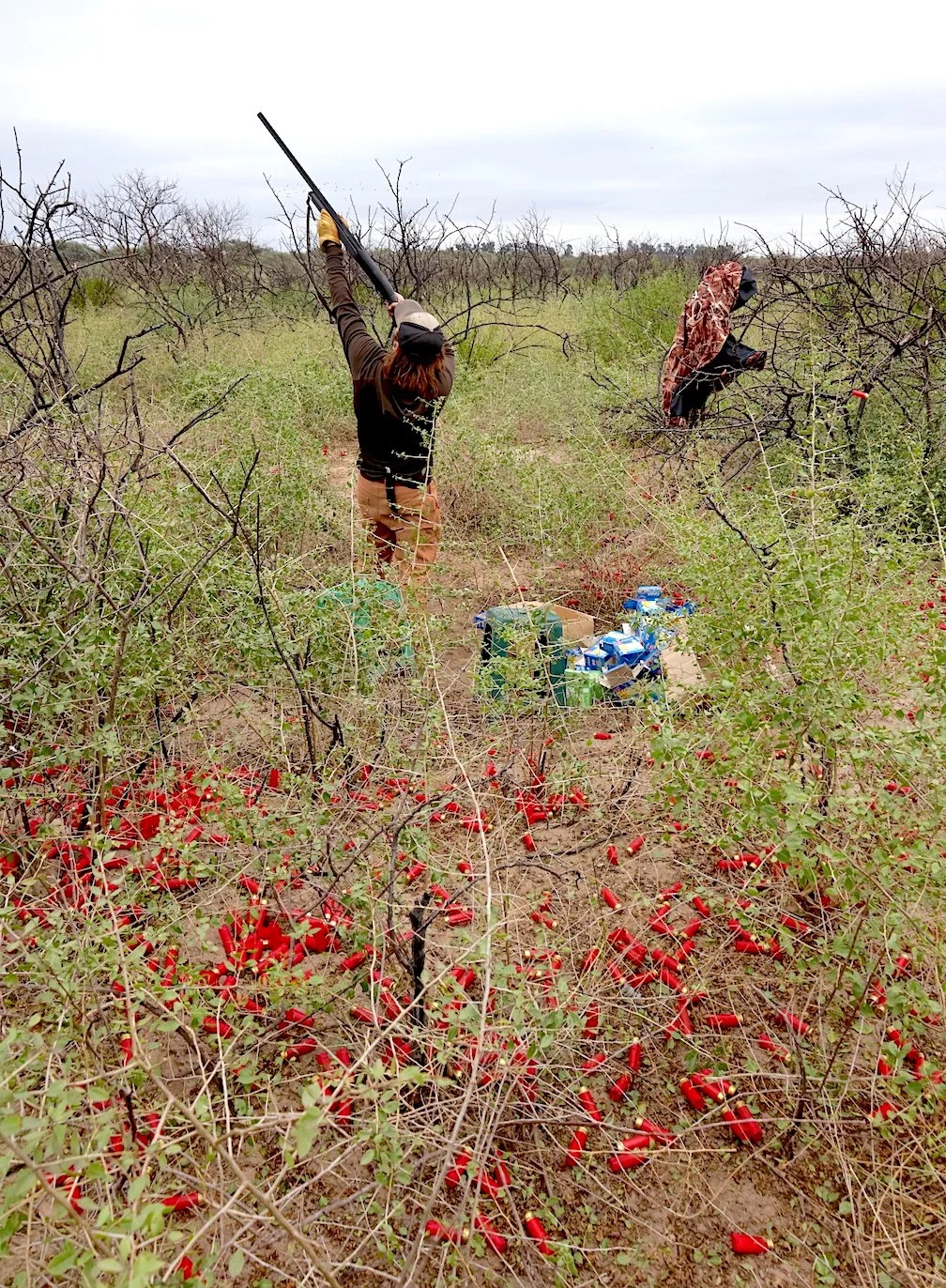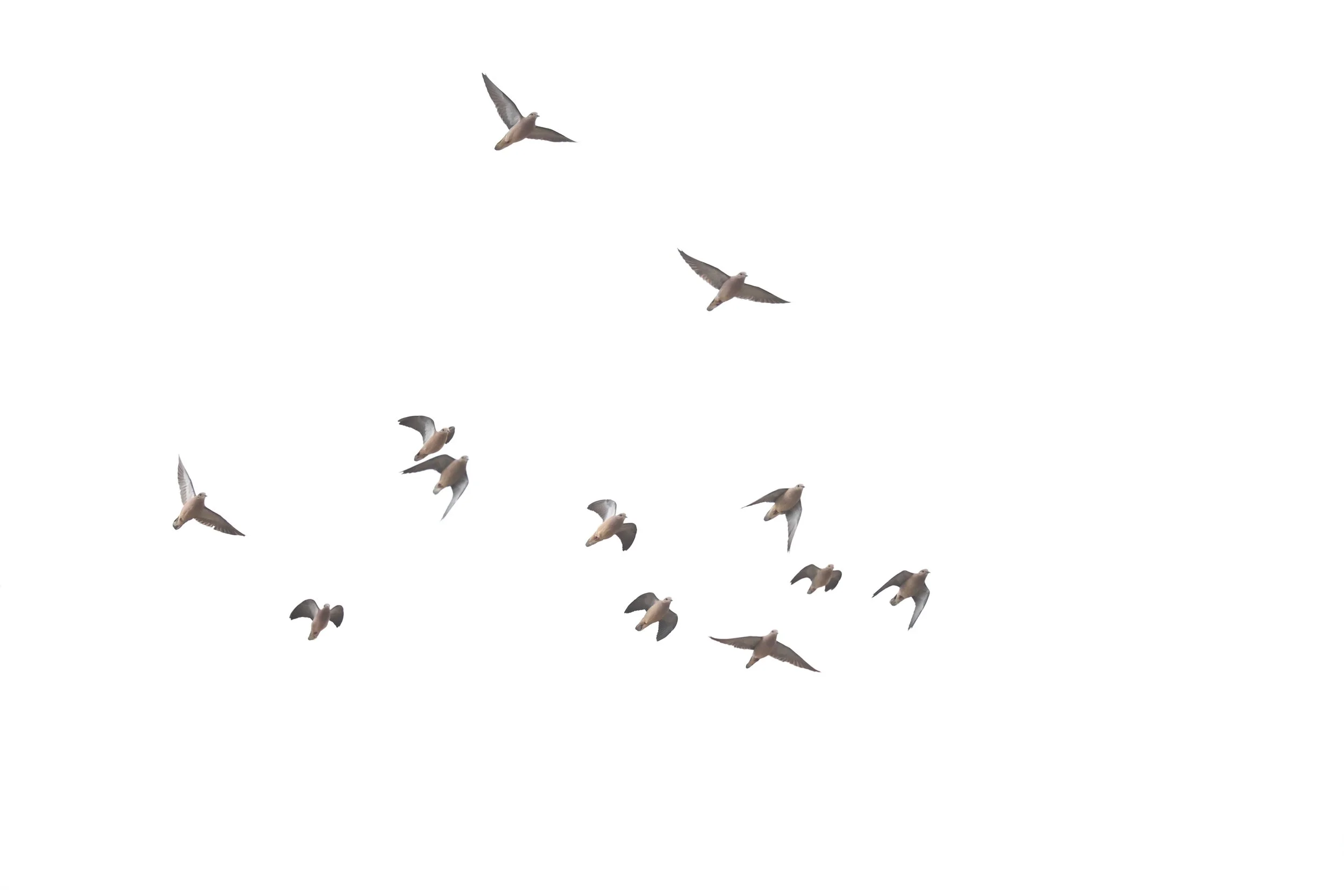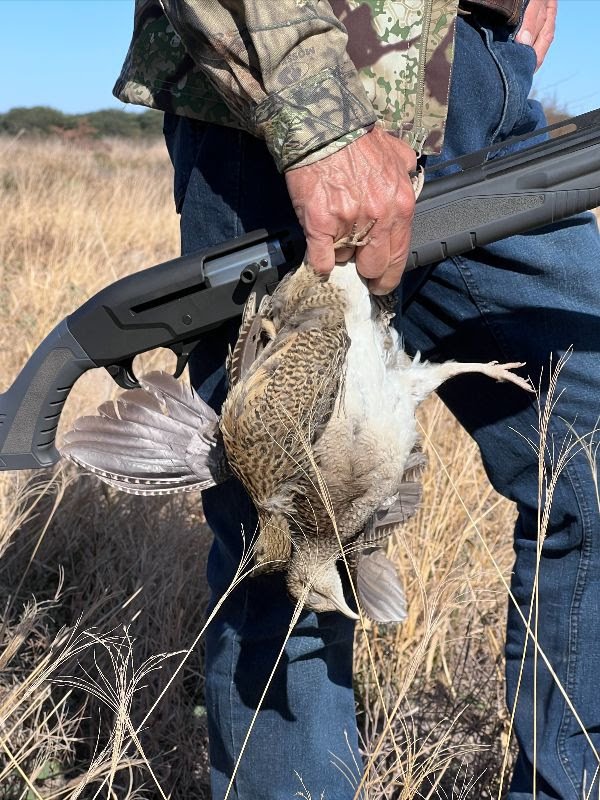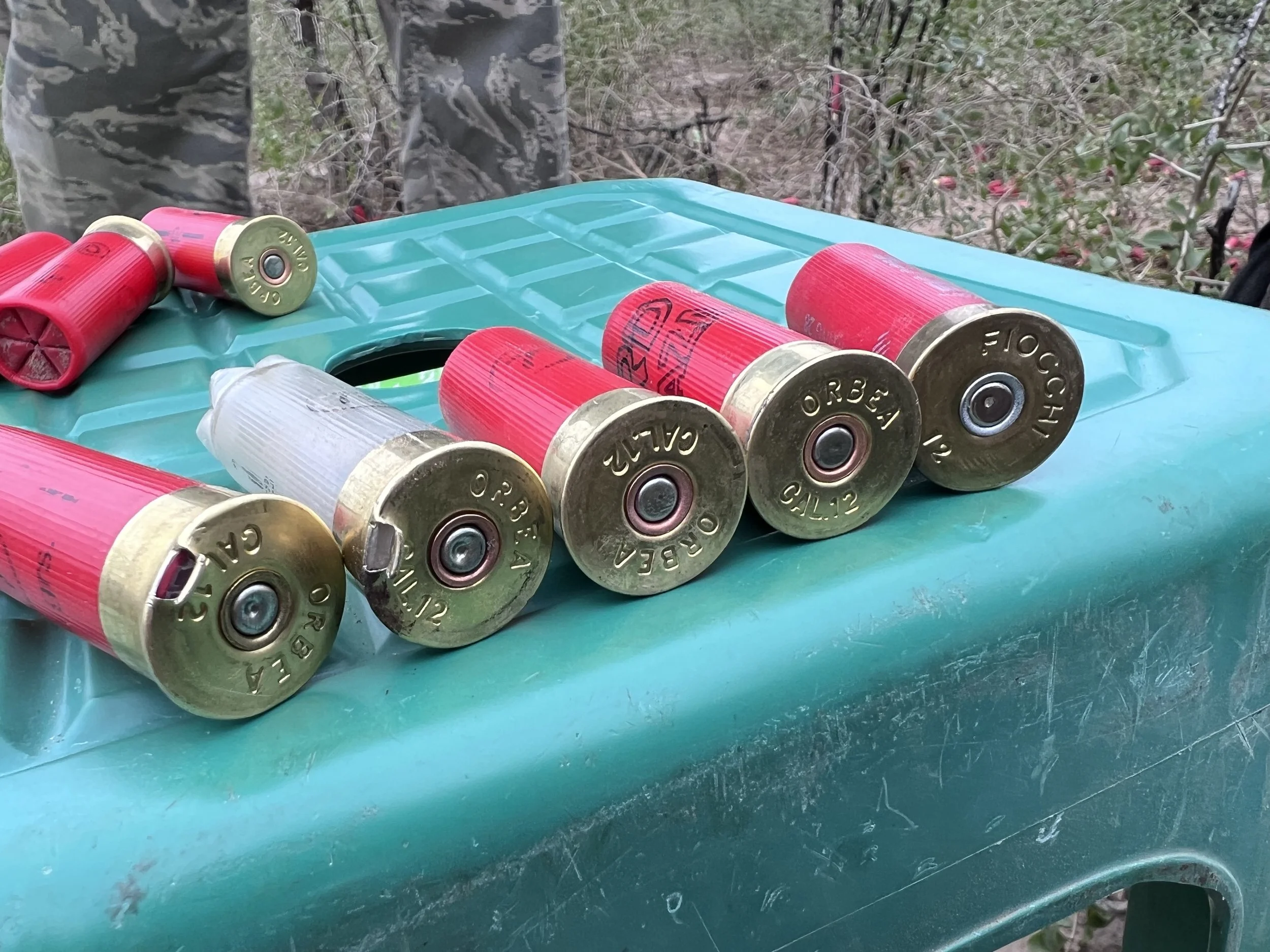How to Bird Hunt
What you’ve heard about Argentina bird hunting is likely true. There are so many doves and pigeons in many agricultural regions that they are pests and can be shot without limit. This means the wild stories you’ve heard about shooters taking 3,000, even 5,000 doves in a day are likely true. Even an average shot with a relaxed approach can quickly pile up 1,000.
David Herman proved one of the more consistent dove shooters, swinging his Savage Renegauge well to hit a high percentage of passing birds, long range and close. Note his extended “pointer” arm technique. Many use this to aid in a natural point toward the targets.
If this sounds excessive, relax. You don’t have to indulge in high volume shooting. You are welcome to set your agenda, anything from an hour of shooting in the morning to an hour in the evening or a personal limit of 100 shells or 100 birds… whatever. Mix in a few decoying pigeon shoots or walk up the famous, hard flushing perdiz behind pointing dogs. Hit the wetlands for some duck shooting.
Here’s how it happens:
You book a hunt through an Argentine outfitter. We used Cerro Indio Safaris most recently. They should take care of everything once you land in Buenos Aires. An interpreter/guide will greet you at the luggage carousel and drag you through the necessary police and Customs gun permitting red tape.
Following the usual tedious bureaucratic maneuvering (be patient), you’ll be whisked to your connecting flight or an overnight hotel until the next morning’s in-country flight. Again, a guide will see you through all the hoops, which don’t amount to much more than language barriers if you don’t speak Spanish. Modern city, all the usual stuff including traffic!
Once your in-country flight reaches your “final destination,” your outfitter will be at that airport to run further interference with local police before driving you to your lodge where you’ll likely enjoy snacks, dinner, or a refreshing drink before heading out for your first “shoot,” likely a dove flyway.
Here is where your training, fun, and possibly frustration begin. If you’re an accomplished dove shot, just enjoy. If you’re missing too much, you have time to analyze and correct. If you can’t detect that you’re lifting your head off the stock at the shot or failing to focus on one bird or stopping your swing or… whatever, consult your “bird boy.” This won’t be a boy so much as a man or woman charged with keeping you supplied with shells, policing your empties, counting your hits and misses, and picking up the downed birds. Often local farm workers come in to share in the harvest.
Geronimo and Josephine were working as cheerful “bird boys” on our recent Argentine dove shoot with Cerro Indio Safaris.
Anyway, back to my — I mean your — poor shooting. If you can’t figure it out, ask your bird boy. He’s likely had so much experience that he can tell you what you’re doing wrong. Now, here comes the valuable part: you have thousands of opportunities to correct yourself!
On that next flock (which will probably arrive ten seconds after the last one) you can focus on focusing on a single bird. Forget the flock. Pick one. Now keep your head down, swing through, keep swinging and follow through. Uno! Repeat.
One of the difficulties in hitting doves is the confusion of the flock. You must choose one and stick with it.
I was having my usual “shot him in the tail” frustration one year down there when I put the above advice into effect. I analyzed that I was not leading enough, forced myself to swing way farther ahead than I ever do on upland birds or decoying ducks, and began powdering doves. I went from one every two or three flocks to two or three per flock and eventually to quatro! Four birds from one passing bunch!
On this recent shoot, I never got that good, but managed an average hit rate of 54% with several doubles and a few triples in the mix. It seems 70 years hasn’t improved my reaction time.
Doves and pigeons look fast because they fly fast. Insuificient lead is the culprit behind most misses.
After that break-the-ice dove shoot, you’ll be entertained with adult libations and fine dining back at the lodge, likely with a cheery fire crackling. You’ll undoubtedly be offered a fine Argentine red wine called malbec. Highly recommended for lowering blood pressure and aiding digestion and sleep.
Dinner is served.
Perdiz, a ground bird that’s not really not a partridge at all, but a tinamou, are hunted much like our partridges, grouse and pheasants. Walk the grass with a pointing dog, shoot the fast flying little birds when they flush. And then enjoy their delectable white-meat at dinner.
The next morning might be another high volume dove shoot or a pigeon shoot over decoys in a soybean field. Perhaps you’ll get to walk up perdiz behind the dogs. The limit is usually just five birds, which seems skinny after the dove shoot, but downright generous compared to stateside pheasant limits. If they take you for ducks over decoys, the limit might be 10 or 15 birds.
I didn’t double on this brace of perdiz, but took them within a minute of one another. Note the size and color differences. Each bird is a different species of tinamou. There are 47 species Central and South America.
Rinse and repeat. You and/or your party will probably be allowed to alter or set your agenda. Most like a taste of everything, but some hard-core shooters just want to work on those crop-eating doves and cement their pass shooting skills, working on high crossing left-right targets or birds going away or whatever. I like mixing in some photography, a bit of birding. You should see parrots, many falcons, hawks, eagles, caracaras, and what looked to me like the same burrowing owls we have in the States.
Monk parrots were one of the common birds that added spice to our Argentina hunts.
Other birds were common and diverse, but without a detailed ID book, I couldn’t determine if this was a buteo hawk or some kind of eagle.
Many Argentine hunts run just three days to take advantage of “the long weekend.” From Atlanta it’s about a nine-hour flight to Bueno Aires, so figure two days of travel added to your shooting days.
On this latest trip six of us “test drove” Savage’s Renegauge gas-driven 12 gauge guns, but most shooters prefer 20 gauge. Our objective was to run the Renegauges hard and dirty. One shooter — who’d installed an extended magazine tube on his gun — burned through thousands of rounds without ever cleaning. And he’d sometimes rapid fire 12 rounds! His gun never failed to fire, but several times the empties stayed in the chamber, the extractor hook ripping through the rim in a vain attempt to free it from the ridiculously dirty, tight chamber.
The Savage Renegauge shotguns we were brutally testing are a gas drive system engineered to be worked hard and dirty. I’d routinely shoot 100 to 1,000 shells without cleaning. Only when dirt and carbon built up in the locking lug recesses or under the trigger did my gun fail to fire.
Carbon build up in the Savage Renegauge autoloading shotgun eventually interfered with some functions, but overall the guns proved reliable and durable through more than 25,000 rounds fired over the course of a week.
These shells show how one shooter’s gun ripped rims off of shells stuck in his extremely hot, dirty chamber. Those with light primer strikes indicate what happened when my bolt locking lugs couldn’t fully close due to dirt and debris. Cleaning fixed all these road blocks.
One of the nicer attributes of the Reneguage is its smooth, scalloped lifter that funneled shells via a generously open loading port into the magazine. Slick and quick.
My gun began misfiring after several hundred rounds, putting faint firing pin marks on the shell primers. Cleaning carbon from the locking lug recesses solved that. Another time the trigger refused work. Cleaning dirt and debris from the unit fixed that. Several other shooters had similar issues which, from the perspective of a North American hunter, would likely never pop under over an entire season of the limited shooting we encounter. Who doesn’t clean his or her shotgun after firing a box or three of shells?
It was winter and extremely dry where we hunted in Santiago del Estero province, dirt and dust from farm fields billowing and swirling at every step, so shooting without cleaning was asking for trouble.
The worst issue any of us had was my muzzle burst. While enjoying a fast and furious picazuro pigeon hunt, I was stopped mid-action by my bird boy. He directed my attention to the muzzle of my gun. Bulged and split open! At first we thought a 20 gauge shell had inadvertently gotten into the mix, but that would have lodged much nearer the chamber to burst the barrel. The choke was gone, so we decided my fast and furious shooting had gradually vibrated the choke tube out until it created enough thread surface friction to capture a wad. The next shot slammed into this wad to cause the barrel to split. I was able to borrow a 20 gauge Beretta from the outfitter, but by the next afternoon its choke was unscrewing itself, too! This brings up several useful tips: Lube and screw your chokes in tight. Check them at least every 100 shots. No matter how durable and reliable your gun has been, clean it every evening. Finally, consider taking two guns down there. Many hunters, if not most, do.
Choke tube disaster. Because I either didn’t tighten my screw-in choke enough or failed to check it after hundreds of shots, it loosened enough to capture a shot cup wad. The next shot met the obstruction and overstressed the barrel. This 28-inch Renegauge barrel will likely become a 22- or 20-inch short barrel.
Costs for these hunt varies by lodge amenities, current inflation, etc. Some outfits advertise three days of shooting with accommodation plus 2,000 shells for $3,000. High end lodges can run more than $7,000 per day. Seek and ye shall find. But if you wish to taste the most incredible, high-volume bird shooting on the planet, you need to try Argentina.
P.S. Lest you think hunters are wiping out the pigeons and doves, understand the populations of both are increasing annually. Last time I checked there were an estimated 30 to 50 million doves in northern Argentina alone.
The line-up. I’m not a fan of big bag photos like this, but our outfitter went through all the trouble of lining out these pigeons so… It does give you a dramatic idea of how much shooting you can do down there. The lodge chef made some delicious pigeon meals.
High volume shooter True Pearce demonstrates how rapidly his Savage Renegauge can sling shots downrange. True often uses extended shotgun magazine tubes during high volume 3-Gun competitions.
This is dove shooting from the bird boy’s perspective. David is making the shells fly while trying to make the birds die. About half the time he succeeded.



















